For a brief shining moment, trolleybuses graced the streets of Glasgow. They were handsome, sleek and powerful machines, capable of rapid acceleration, yet virtually free from noise or vibration. And they had a good safety record. At one time it was thought that they would be the natural successors to the trams. Like the trams, they were electric, but they did not require rails and so they could pull into the kerb, making it much safer for passengers to get on and off the vehicle. But for all these qualities, Glasgow’s trolleybuses lasted only 18 years. They arrived with much fanfare in April 1949, reached their peak in 1959, and then fell victim to progressive attrition, largely on economic grounds, until their last service ended quietly in May 1967.
Please note that all the photographs here are ones that I have purchased or have permission to use. If any are under copyright, could the owner(s) please contact me and I will request permission to post, and acknowledge them. The text is © Christopher J. Jones.
The Six-Wheelers
My first recollection of Glasgow’s trolleybuses was seeing them as they passed through Mount Florida on the 105 service, running between Queen’s Cross in Maryhill and Clarkston in Renfrewshire. Sometimes they would make a short stop on the Southside at Mount Florida or Muirend. They had been introduced on this route on 5th July, 1953 to replace the tram services 5 and 13. The 105 was not, however, the first trolleybus service to operate in Glasgow. That honour belonged to the 102 which began running just after 12 noon on a wet Sunday, 3rd April, 1949, when the immaculate six-wheeler trolleybus TB 2, FYS 702 emerged from Larkfield Garage in Govanhill and was driven at a stately pace to Riddrie. The route followed by the 102 service from Polmadie to Riddrie was via Aikenhead Road, Cathcart Road, Crown Street, Albert Bridge, Saltmarket, Glasgow Cross, High Street, Castle Street, Royston Road and Provanmill Road. Four more six-wheeler trolleybuses with chassis built by British United Traction ( B.U.T. ) and bodywork by Metropolitan Cammell, entered service that day and the rest of the schedule was made up with AEC Regent diesel motorbuses.
The Glasgow Evening News reported the next day that “Glasgow gave a wholehearted welcome yesterday to the new trolleybuses, and the fact that there were 20,000 passengers in the space of 12 hours suggests that the novelty made a big appeal. From mid-day till a few minutes before midnight the silent green, cream and orange six-wheeler trollies kept a 15-minute service going from Polmadie to Provanmill. At each bus stop, queues formed, and although the old diesel buses drew up to relieve the congestion, few passengers stepped aboard.” They clearly wanted to experience this brand new form of transport in Glasgow and were not disappointed. And so it began, and by 1st May 1949 route 102 was serviced entirely by trolleybuses. Glasgow was the last major city in the United Kingdom to adopt the trolleybus as a significant form of public transport and I’m certainly glad they did. I became a big fan.
The first batch of 34 six-wheeler trolleybuses were in the TB series ( TB 1-34, FYS 701-734 ) with T standing for Trolleybus and B for B.U.T., the AEC – Leyland trolleybus consortium that built the chassis. The second batch of another 30 vehicles was the TD series ( TD 1-30, FYS 735-764 ) where the D is an abbreviation for Daimler who supplied the chassis for this batch. Both the TB and TD series had bodywork very similar to London Transport’s Q1 trolleybuses and were finished to a very high standard. In Glasgow’s case, they were painted in a handsome livery of sage green lower panels, cream between the decks with orange relief bands, and a cream roof. Each vehicle could carry up to 70 passengers, with 40 downstairs and 30 upstairs. The seats coverings were of green moquette trimmed in leather, and the window surrounds were of polished walnut. The first photographs here show these vehicles at various times during their service life. The TB series was delivered with London Transport Style trolleybus transfers as shown in the first three photographs below. This series outlasted the TD examples and the six-wheelers saw service on routes 101-105 but very rarely, if at all, on routes 106-108.
Six-wheeler trolleybus TB 30, FYS 730, on service 102 operating between Riddrie and Hampden Park is seen in the Saltmarket passing the High Court in 1949. The trolleybus is in immaculate condition so this photograph was probably taken soon after the 102 service was inaugurated in April and the southern terminus extended to Hampden Park on 3rd July. The London Transport – style trolleybus roundel is clearly visible on the front lower panel and there is a smaller roundel by the entry platform where the transport inspector is standing. A third roundel was on the lower rear panel. These transfers were only present on the TB series of trolleybuses and were subsequently removed following objections from London Transport. The City of Glasgow Coat of Arms is clearly visible on the upper cream panel. ( Photograph from the GEC Collection, kindly provided by David Beilby. )
Trolleybus TB 8, FYS 708 on service 101 bound for Shawfield from Cathedral Street is seen heading south at Glasgow Cross, most likely in early 1950. The 101 service had been inaugurated on 6th November 1949 but was not completely operated by trolleybuses until 5th February, 1950. The City of Glasgow crest has now been transferred to the lower green panel, perhaps in readiness for a Milanda Bread advertisement to be pasted onto the upper panel. A line of traffic has built up behind the vehicle and we can see Bow’s Department Store in the distance, on the corner of High Street with Bell Street. ( Photograph from the GEC Collection, courtesy of David Beilby. )
Six-wheeler trolleybus TB 9, FYS 709 on service 101 is heading south to Shawfield down a busy Saltmarket in early 1950. TB 8 first came into service in April 1949 on service 102 and still looks quite clean more than 6 months later. We can see four different modes of traction in this picture; electric, internal combustion engine ( diesel and conventional ) and horse-drawn. ( Photograph from the GEC Collection, courtesy of David Beilby. )
A fascinating photograph taken by R. B. ( Bob ) Parr on Saturday 19th August, 1950 when he was leading an outing with the Light Railway Transport League ( LRTL ). The location is Maxwelton Road, between Hallbrae Street and Barwood Street at the Riddrie terminus of the 101 and 102 trolleybus services. In attendance is Mr. Chamberlain, the Trolleybus Engineer for Glasgow Corporation Transport ( G.C.T. ) standing beside the brand new Daimler TD 29, FYS 763. Notice the cream roof and the Glasgow Coat of Arms on the broad cream band running along the side. What a magnificent vehicle! There is another trolleybus off camera to the right whose the driver appears to be dealing with a dewirement where one or both booms have come off the wires. He is using the very long bamboo pole that was stored in a tube underneath the vehicle for the purpose.
In this 1951 scene, two six-wheeler trolleybuses are heading south over Albert Bridge. The leading vehicle, TD 15, FYS 749, is a recent acquisition on service 102. It is followed by TB 17, FYS 717 on service 101, between Shawfield and Cathedral Street, a service which had been completely operated by trolleybuses since 5th February, 1950. Notice the London Transport-style trolleybus roundel on the front of the second vehicle. Both vehicles still have their cream roofs. They also have via screens in addition to their number and destination screens.
Here, six-wheeler TD 26, FYS 760 is coming down the High Street on service 104, operating between Cathedral Street and Muirend. Trolleybuses on this service commenced operation on 31 August, 1952. The cream roof has now been repainted green and the upper orange relief band has been painted over in cream. The original cream roofs would quickly gather grime in the Glasgow air and this was not helped by additional soot deposited from the trolley booms. The Clean Air Act would not be passed until 1956.
In the background is Bow’s which was a fixture on the High Street for many years. It started out in 1873 as William Bow’s wholesale hardware business at number 91 and later blossomed into Bow’s Emporium, a department store with a specialty in home furnishings, and with wrap around frontage on High Street, Bell Street and Walls Street.
This shows TD 7, FYS 741 traveling along Aikenhead Road towards the depot at Hampden Garage which was just below Hampden Football Stadium. The purpose-built depot began operations on 17th December, 1950 and over two-thirds of Glasgow’s trolleybus fleet would be based there.
The Glasgow Coat of Arms that used to be positioned on the upper side panel of the trolleybus has now been obscured by the advertisement, so a new transfer has been affixed to the lower panel. Note the prefabricated homes ( prefabs ) in the background. They had been built to overcome the post-Second World War housing shortage in Glasgow and there were many of them in the area, including in Toryglen, and along parts of Aikenhead Road and Prospecthill Road.
In this scene, the six-wheeler trolleybus TD 12, FYS 746 on service 105 is heading north over Victoria Bridge on its way to Queen’s Cross. This service from Clarkston with short stops in Muirend and Mount Florida had been instituted on 5th July, 1953 and was the first trolleybus service to go through part of the city centre. The trolleybus shown here is now in its second livery where the lower panels have been changed from green to orange and the orange band above the lower deck window had been repainted green. The via panel on the front of the trolleybus has now been blanked out. Perhaps the folk at the G.C.T assumed that passengers would know the route by this time.
Daimler six-wheeler trolleybus TD 6, FYS 740, on route 105 from Queen’s Cross to Mount Florida, is seen passing the Gushet Bar in Cowcaddens in the late 1950’s. This aptly named bar was situated at the junction of Cowcaddens Street and Port Dundas Road. All of the buildings in this scene have since been swept away but the curious heraldic monument, known as the William Annan Fountain, has been preserved. Constructed of polished pink granite, it was presented to the city by wealthy publican and wine merchant William Annan of Port Dundas in 1915. In the year 2000, the fountain was relocated to the square at the top of Renfield Street, created when the north end of the street was closed off. I understand that the fountain is no longer operational because it is not connected to the water main. (Photograph attributed to Ian Semple.)
TB 4, FYS 704 bound for Polmadie on service 102 is seen here at the Riddrie terminus on Maxwelton Road in the late 1950’s. Note the prefabricated homes ( prefabs ) on the left. They had been built in Glasgow suburbs to alleviate the post-Second World War housing shortage. (Evening Times photograph reproduced by kind permission of Ian Todd and the Glasgow Chronicles.)
There is quite a performance going on here in this early 1960’s scene as repairs are being made to the overhead wiring on Provanmill Road at the the approach to the Riddrie terminus loop on service 101 from Shawfield. The double-deck trolleybus in the left-hand lane will be turning right onto Barwood Street just beyond the repair lorry. Then it would turn left onto Maxwelton Road, take the first left onto Hallbrae Street, followed by a left turn back onto Provanmill Road. That was the loop. The repair is being made close to where the overhead wires cross so that is why all of the trolleybuses are having to dewire and then rewire further on. They would go round the interruption on battery power. ( Photograph attributed to Ian Semple. )

Daimler six-wheeler TD 10, FYS 744 on service 105 to Queen’s Cross is seen in St. Vincent Place in 1961, photographed from the corner with Buchanan Street. Part of the City Chambers can be seen in the background. The trolleybus will cross Buchanan Street, then turn right and head up West Nile Street on its way to Cowcaddens and Maryhill. The Leyland Titan PD2 motorbus in the picture is on service 2 from King’s Park to Knightswood. (Photograph copyright Pamlin Prints, Croydon.)
An impressive array of very clean-looking trolleybuses at Hampden Garage in the early 1960’s. The five vehicles closest to the camera are six-wheelers, three AEC – Leylands and two Daimlers, then there are two four-wheel Sunbeams in their new livery of yellow and green, with different bodywork, the first by Weymann and the second by W. Alexander. After this, we have a mixture of six-wheel and four-wheel trolleybuses. A very fine array, and sadly not one of these types preserved. ( Photographer unknown. )
This photograph shows Glasgow’s very first numbered trolleybus TB1, FYS 701, having left Polmadie en route for Royston Road on service 102. This vehicle had been operating since 3rd April, 1949 and would outlast the TD series which had been introduced later. The route of the 102 service was cut back from Riddrie to Royston Road on 2nd September, 1962.
TB 24, FYS 724 is coming down High Street and passing the entrance to Duke Street as it heads for Rutherglen on service 101 in early 1966. This trolleybus is in its third and final livery of yellow lower half and green upper half. The 101 service would be withdrawn at the end of April 1966, not long after this photograph was taken, and it would be replaced by motorbus service 27.
The Single Deck “Standee” Trolleybuses
The first vehicle in this series, TB 35, FYS 765 ( later renumbered TBS 1, the S being for single-deck ) made its appearance on service 102 between Polmadie and Riddrie on 5 March, 1951. Built on a B.U.T. chassis with Weymann bodywork, this trolleybus was a novelty in four respects.
First, it was single-decked, which although standard on the Continent, was rare in the British Isles where most trolleybuses, and motor buses that were not luxury coaches, were double-decked. Why waste the opportunity of transporting more passengers? Add another deck.
The second unique feature in TB 35 was that the seating accommodation was drastically reduced so that the floor space could be increased, the intention being to maximize profits by packing in as many passengers as possible and having most of them stand. Hence the term “Standee”. The Transport Manager, E. R. L. Fitzpayne, famous throughout the city because his name was stencilled on all Corporation Transport vehicles, had been impressed by this concept of “ crush loading “ when he attended an International Union of Public Transport conference in Stockholm in 1949. The Glasgow Corporation “Standee” trolleybus was built largely to his design to carry a total of 66 passengers with 26 seated and 40 standing. That’s almost as many passengers as the 70 who could be carried in the double-deck six-wheelers of the TB and TD series, and they were much more expensive vehicles to purchase and to run. So the Standee, if successful, would clearly score on economic grounds.
The third unique feature was the presence of a conductor’s pay desk on entry so that all fares could be collected, another financial plus, as no one could travel without paying. However, the fact that people had to wait longer in line to get onto the bus caused inevitable delays and further inconvenience to the fare-paying public
Lastly, the trolleybus had separate entrance and exit doors which was not the case with the rest of the bus and trolleybus fleet. The intention of the separate doors was presumably to enhance flow, with passengers entering at the rear door where they would pay, and exiting at the front. But it seems that no one had considered the possibility that passengers might get confused and try to use both doors for entrance and exit. And what about the draft that would run through the bus on cold Winter’s days when both doors were open?
The planners thought that the Standee as designed was a godsend. Its design was so revolutionary that TB35 was exhibited by Weymann at the International Commercial Motor Transport Exhibition at Earl’s Court in 1950 and visited by the then Minister of Transport, Mr. Alfred Barnes. After initial testing with TB 35, a further 10 vehicles were ordered in May 1952 and were delivered in February 1953 ( TBS 2 ) and July 1953 ( TBS 3 – 11 ).
It is remarkable how the views of the planners differ so much from those of the traveling public. The planners thought it was a great idea to maximize profits by designing a vehicle where passengers could be packed in like sardines during peak periods. That’s probably why fares were collected on entry because the conductor would not be able to get through the crush inside once the vehicle was full. Passengers were indeed confused by the entrance and exit doors and so the rear entrance was subsequently removed together with the conductor’s pay desk, first in TBS 11, and then in further members of the class. The Standees were not a success and were subsequently relegated to supporting duties before being removed from service altogether in November 1964.
Single-deck Standee trolleybus, TBS 6 FYS 770, is seen at Glasgow Cross, heading south on service 104, bound for Hampden Garage where it would be going off duty. This vehicle had been licensed in July 1953 and the photograph was probably have been taken soon after it entered service. There are separate doors for entry and exit. Passengers were supposed to enter by the rear door where a desk and ticket machine were installed for the conductor to collect the fares. ( Photograph from the GEC Collection, courtesy of David Beilby. )
TBS 6 is seen again, this time on service 104 in the Saltmarket and bound for its regular southern terminus at Muirend. The 104 service had been introduced on 30 August, 1952 and was operated by six-wheeler trolleybuses before the single-deck trolleybuses were available. ( Photograph from the GEC Collection, courtesy of David Beilby. )
This shows TBS 11 in relatively new condition on Maxwelton Road between Hallbrae Street and Barwood Street at the Riddrie terminus. Service 103 had been introduced on 6th August, 1950 and ran between Riddrie and Hampden Park.
Here, Standee TBS 8 and the six-wheeler TD 23 are on Aikenhead Road on service 102 returning to Hampden Garage, the purpose-built trolleybus depot, which came into operation on 17 December, 1950. TBS 8 is showing signs of wear and tear, and is in need of a good wash, some bodywork attention, and its roof painted over green.
Standee TBS 2, FYS 766, is seen at the turning circle at Muirend on service 104 which was introduced on 31 August, 1952 and ran between Muirend and Cathedral Street. In those days, there was still a muir ( moor ) at Muirend which was known locally as the cowp. TBS 2 still has its cream roof which would later be painted green.
Here is TBS 2 again, this time with a green roof, and if trolleybuses had feelings, then TBS 2 would certainly be embarrassed by this double dewirement at Glasgow Cross, while heading south to Shawfield on service 101, circa 1959. Two members of Green Staff are coming to the rescue with their long bamboo poles. ( Original photograph )
Here, Standee Trolleybus TBS 5, FYS 769 is seen leaving Hampden Garage to take up service on route 102 with destination Cathedral Street. This vehicle is now in its second livery and the separate rear entrance has been removed, so this would date the photo to sometime in the early 1960’s. (Photograph copyright A. J. Douglas.)
Here, Standee TBS 8 and six-wheeler TB 8 are heading south on Albert Bridge on service 101 to Shawfield and the home of Clyde F.C. at that time. Both trolleybuses have now had their cream roofs painted over green and TB 8 is in its second livery, with orange lower panels.
The Sunbeam Trolleybuses
These trolleybuses comprised the TG Series with T being the abbreviation for trolleybus and G for Guy. ( The Sunbeam Trolleybus Company was a division of Guy Motors and they built the chassis. ) Twenty of these double-deck vehicles had been ordered for the 105 trolleybus service, which was to run between Clarkston in East Renfrewshire and Queen’s Cross in Maryhill. This would be the first trolleybus service to pass through part of the City Centre and the Corporation had been working on it since early 1950. It was their preference to avoid having trams and trolleybuses running on the same streets because of the likelihood of congestion. The 105 was to cross the Clyde at Victoria Bridge and so existing tram services 5 and 24, already using the bridge, were re-routed to cross the river at Jamaica Bridge. In addition, tram services were removed from West Nile Street in order to make way for the trolleybus service. Overhead wiring was installed along the intended route between Clarkston and Queen’s Cross, and part of this came into use when trolleybus service 104 was introduced between Muirend and Cathedral Street on 31 August, 1952.
A curious feature of the Sunbeam trolleybuses was that the first five examples, TG 1-TG 5, FYS 776-780, had bodywork completed by coach builder Walter Alexander & Company, and the remaining fifteen, TG 6-20, FYS 781-795, were bodied by Weymann. These body styles were quite different as can be seen in the accompanying photographs and there was also a slight difference the livery. The vehicles themselves were 27 feet long, 3 feet shorter than the six-wheelers, and could carry up to 62 passengers. Not all of the TG class were licensed in time for the opening of the 105 service on 5th July, 1953 and so supplementation when required was provided by other vehicles.
This shows the lead Sunbeam trolleybus, TG1 FYS 775, in immaculate condition soon after its delivery in Spring 1953, with Alexander’s coachwork characterized by an almost vertical frontage and pronounced rounded corners. The front screens show service 103 with destination Hampden Park, but it’s likely that the trolleybus was not in service at that time. The absence of the driver and any passengers suggest that this was a set piece photograph arranged by Glasgow Corporation Transport.
New, Alexander-bodied Sunbeam trolleybus TG1, FYS 776, absolutely gleaming in its first livery, is passing George Square on service 105 soon after the service was introduced on 5th July, 1953. The City Chambers are in the background and the trolleybus is heading west along the south side of George Square towards St. Vincent Place from where it would turn right, up West Nile Street. There is a crowd at the scene but I don’t think this assembly was for the inauguration of the trolleybus service because on such an occasion I would expect the bus also to be packed. ( Photograph from the GEC Collection, courtesy of David Beilby. )
Alexander-bodied Sunbeam trolleybus TG 2, FYS 777 is on Hanover Street and about to turn left into George Square, northbound on service 105. So why is the trolleybus displaying the southern destination of Mount Florida, instead of its usual northern destination of Queen’s Cross in Maryhill? You would think that this error would have been pointed out by passengers boarding along the route. Perhaps the explanation is that the trolleybus was only going as far as George Square before turning around and heading back south to Mount Florida, in which case the conductor may have only just made the change to the destination on the screen. (Evening Times photograph reproduced by kind permission of Ian Todd and the Glasgow Chronicles.)
Weymann-bodied, Sunbeam trolleybus TG 10, FYS 785, is seen here picking up passengers in Glassford Street while northbound on service 105. The bus is in immaculate condition so this photograph would probably have been taken soon after it was introduced into service on this route in July 1953. ( Photograph from the GEC Collection, courtesy of David Beilby. )
TG 15, FYS 790, on Service 101 from Shawfield to Cathedral Street, is heading north on Albert Bridge in the Summer of 1953. The Cathedral Street destination was a short stop for this service which had been extended to Royston Road in August 1950. ( Photograph from the GEC Collection, courtesy of David Beilby. )
Sunbeam trolleybus, TG 14 FYS 789, on service 102 from Riddrie to Polmadie, is seen dropping off passengers in the Saltmarket, most probably in 1953. An earlier, six-wheeler trolleybus is visible in the background. ( Photograph from the GEC Collection, courtesy of David Beilby. )
A Sunbeam trolleybus in relatively new condition is collecting passengers at the foot of West Nile Street on Service 105 to Clarkston, most probably in 1954. This is where we would catch the trolleybus back to Mount Florida after a Saturday morning in town.
There are some bright, shiny cars in this scene including a Vauxhall Wyvern stopped at the traffic lights and most likely a Hillman Husky parked by the kerb. A split-screen Morris Minor is overtaking the trolleybus, and a Standard Vanguard is parked at the kerb behind it.
( Photograph reproduced by kind permission of Ian Todd and the Glasgow Chronicles. )
This shows Sunbeam trolleybus TG 12, FYS 787, on service 102 emerging from Darnick Street onto Royston Road as it sets off for Polmadie. The homes on Royston Road are still there, having been modernized and their chimney stacks removed. but the tenements behind on Forge Street have been replaced with semi-detached homes. ( Photograph copyright Ian Semple. )
Alexander – bodied Sunbeam trolleybus, TG 3, FYS 778, is seen downtown on service 105 bound for Queen’s Cross sometime in the early 1960’s. The bus is still in good condition and has recently been repainted into its Phase III livery with yellow lower panels and green upper works.
Weymann – bodied Sunbeam trolleybus, TG 16, FYS 791, is seen here in Brerton Street at the Polmadie terminus of service 102 in the early 1960’s. The trolleybus will soon be turning into Calder Street and heading for Aikenhead Road on its way to Royston Road. The service had been cut back from Riddrie to Royston Road on 2 September, 1962. TG 16 is now in its Phase III livery which was reportedly sprayed on and is now showing signs of peeling off.
The Biggest Trolleybus Order
In 1952, the General Manager of Glasgow Corporation Transport, Mr. E. R. L. Fitzpayne, recommended the replacement of up to 450 early Standard tramcars because it was becoming increasingly expensive to maintain them. However, it would not be until three years later, in June 1955, that the Transport Committee would invite tenders for their replacements which were to comprise initially 135 trolleybuses and 150 diesel motorbuses. Of the 135 trolleybuses, it was proposed that 100 would be double-deck and 35 single-deck. Now although trolleybuses generally cost more than diesel buses, the Corporation wanted to justify the continued operation of its coal-fired power station at Pinkston near Port Dundas. Over two million pounds had recently been spent on modernizing it and the new cooling tower was described as being the largest in Europe at the time. There was, however, some cost-cutting on the trolleybus order which was amended to ninety double-deck and ten single-deck vehicles, the former to be bodied by Crossley and the latter by Burlingham.
The Crossley Double-Deck Trolleybuses
These attractive, contemporary vehicles were ordered with B.U.T. chassis and bodywork by Crossley Motors of Stockport, Cheshire, a subsidiary of AEC. They were 30 feet long and numbered TB 35-114 ( FYS 796-875 ) and TB 115-124 ( FYS 977-986 ). Compared to the six-wheelers, the new double-deckers were somewhat spartan inside. There were no moquette-trimmed seat covers or walnut window surrounds. The paneling inside was bare metal and there was a colder feel as a result. Most of these trolleybuses were earmarked for three new services; the 106, 107 and 108, as well as existing service 105.
Brand new Crossley-bodied B.U.T. trolleybuses are seen on the concourse of Hampden Garage soon after their delivery in the Summer of 1957. At the front is TB 37, FYS 798, one of the first in the series of 90 vehicles that were ordered.
Crossley-bodied TB 40, FYS 801 in nice clean condition is seen here in Gorbals Street on service 105 heading for Queen’s Cross in Maryhill.
Excellent close-up of Crossley-bodied, B.U.T. trolleybus TB 113, FYS 874 passing through Cowcaddens in the late 1950’s on service 105 from Queen’s Cross in Maryhill to the short stop in Mount Florida. Following behind is a Coronation Mark II tram, popularly known as a Cunarder, on service 29 from Maryhill to Glasgow Cross / Tollcross. This tram service would be withdrawn on October 22, 1961 and replaced with motorbus service 61. The trolleybus and tram will descend from Cowcaddens via different routes, the trolleybus via West Nile Street and the tram via Hope Street. To reduce the risk of congestion, Glasgow Corporation tried as much as possible not to have trams and trolleybuses running on the same routes, especially in the City Center, and on bridges across the Clyde.
Two Crossley-bodied B.U.T. trolleybuses, TB 103 and TB 123, introduced into service in 1958 and 1959 respectively, are seen here in Northpark Street, Maryhill, at the Queen’s Cross terminus of service 105 in the early 1960’s. The large tower in the background, partly obscured by the lamppost, is the water tower at Ruchill Hospital.
Fifty-five of these vehicles, a substantial tranche, were assigned to the 106 trolleybus service that was replacing the number 7 tram on the long cross-city route between Bellahouston in the southwest and Riddrie/Millerston in the north-east. In peak periods the service was extended to Linthouse and Shieldhall for the shipyard workers. It began on 15th June, 1958 and the trolleybuses operated initially out of Govan and Dennistoun tram depots. Dennistoun Depot later closed on 5th November, 1960 and after that it was a long run back to Govan for the last bus to Millerston.
Standard tram 292 is at Bridgeton Cross in September 1958 and in the background is one of the new Crossley-bodied trolleybuses on service 106 which had just been introduced in the preceding June.
TB 76, FYS 837 on the 106 service is seen westbound at Gorbals Cross, heading for Bellahouston.
The 107 trolleybus service began running on 7th July, 1957 between Muirend and Maitland Street near Cowcaddens and was a response to requests from members the public in Cathcart and Muirend for a service to the Victoria Infirmary, the major hospital in the area, and to the shops on Victoria Road. These were already served by railway stations at Mount Florida and Queen’s Park respectively but more walking was involved and there were staircases to negotiate. The overhead wiring was already in place for the 107 trolleybuses because the route had been initially provided as a supplement to the 105 service.
This shows TB 44, FYS 805 heading south on Victoria Bridge on service 107 between Maitland Street in Cowcaddens and Muirend on the Southside, just inside the Glasgow City boundary with Renfrewshire. Seen on the left are the masts of the former sailing vessel Carrick, which used to be the tea clipper City of Adelaide. She is moored at Customs House Quay.
The last trolleybus service to be introduced in Glasgow, on 16th November, 1958, was the 108 which replaced the number 12 tram service between Mount Florida and Paisley Road Toll, with peak period extensions to Linthouse and Shieldhall for the shipyard workers. Clincart Road in Mount Florida had served at the terminus for the number 12 tram but this was subequently changed to Ballogie Road for the trolleybuses. Crossley double-deck trolleybuses were employed during peak periods and occasionally during off-peak times and the route was also served by the new 341/2-foot long Burlingham single-deck trolleybuses of which there were 10, namely TBS 12-21, FYS 987-996.
TB 37, FYS 798 is seen crossing the bridge at Strathbungo Station on service 108 from Mount Florida to Paisley Road Toll.
Two Crossley-bodied double-deckers are in Mount Florida collecting passengers on service 108 in its closing days. The service was withdrawn on Saturday 4th March, 1967.
The Record-Breaking Burlingham Single-Deckers
These 10 single-deck trolleybuses with B.U.T. chassis and bodywork by Burlingham of Blackpool set a new British record. They were 341/2 feet long which was 41/2 feet longer than the existing legal limit for two axle buses and trolleybuses in the United Kingdom. The purpose of the extra length was to pack more passengers into a single-deck platform. However, they would require Ministry of Transport approval to operate on British roads. Because service 108 was to run across the Southside and nowhere near the city centre, traffic was lighter, so it was thought that the route might be suitable for running longer public transport vehicles. A feasibility study was conducted with two extra-long Leyland motorbuses destined for export and the clearances were found to be satisfactory. So Ministry of Transport approval was forthcoming and the trolleybuses were ordered.
Single-deck trolleybus TB 17, FYS 992, on Service 108 is on Cathcart Road, passing through Mount Florida on the way to its terminus at Ballogie Road. Stanmore Road is just off on the right and in the background with the Capstan cigarettes sign is the Handy Stores, on the corner of Clincart Road and McLennan Street. Clincart Road served as the terminus for the Number 12 tram which was replaced by the 108 trolleybus service on 16 November, 1958. ( Photo by Bill McAdam and reproduced by kind permission of Ian Todd and the Glasgow Chronicles. )
TBS 20, FYS 995 is seen at the Paisley Road Toll terminus. Note the Rogano Bar on the far left, on the corner of Paisley Road and Admiral Street. It would later be purchased by Jim Baxter, “Slim Jim” of Rangers fame, and be renamed Jim Baxter’s.
TBS 21, FYS 996 is seen at the Paisley Road Toll terminus on Admiral Street in the early 1960’s. A red Morris Commercial Post Office van is parked outside the Post Office next to the Rogano. ( Photograph courtesy the Ministry of Transport. )
TBS 16, FYS 991 is seen here on a peak-period run of service 108 from Mount Florida to Linthouse. The bus is quite full and some passengers are standing. These single-deck trolleybuses were approved for 58 passengers with 50 seated and 8 standing.
Service Withdrawals
103: 9th May, 1959: Service 103 was a southern extension of the 102, terminating at Hampden Park instead of Polmadie, and it was withdrawn without motorbus replacement.
104: 6th January, 1962: Service 104 was also withdrawn without motorbus replacement, but part of the route was covered by some trolleybuses on service 105, terminating at Muirend instead of Clarkston.
106: 11th January, 1966: At approximately 10 miles long, this was Glasgow’s longest trolleybus route, and was replaced by the number 65 bus service.
101, 102: 30th April, 1966: Both of the High Street trolleybus services 101 and 102 were withdrawn on the same day, the 101 being replaced by the number 27 bus service and the 102 was not replaced.
107, 108: 4th March, 1967: Both of these trolleybus services were withdrawn on the same day and replaced by motorbus services 67 and 68 respectively.
105: 27th May, 1967: This was the last trolleybus service to go, being replaced by the number 66 motorbus service. All of the trolleybuses remaining at Hampden Garage were removed to Ibrox Garage to await disposal and Hampden Garage was closed.
This may be the last day of the 108 trolleybus service and TB 123, displaying 123 and Special on its screens, is setting out from Ballogie Road, Mount Florida for Paisley Road Toll. The waiting Daimler motorbus on service 68 will be taking over.
Preservation
Sadly, only two of Glasgow’s 194-strong fleet of trolleybuses survived into preservation, namely the Burlingham-bodied single-deck TBS 13, FYS 988 and the Crossley-bodied double-deck TB 78, FYS 839. None of my beloved six-wheelers survived.
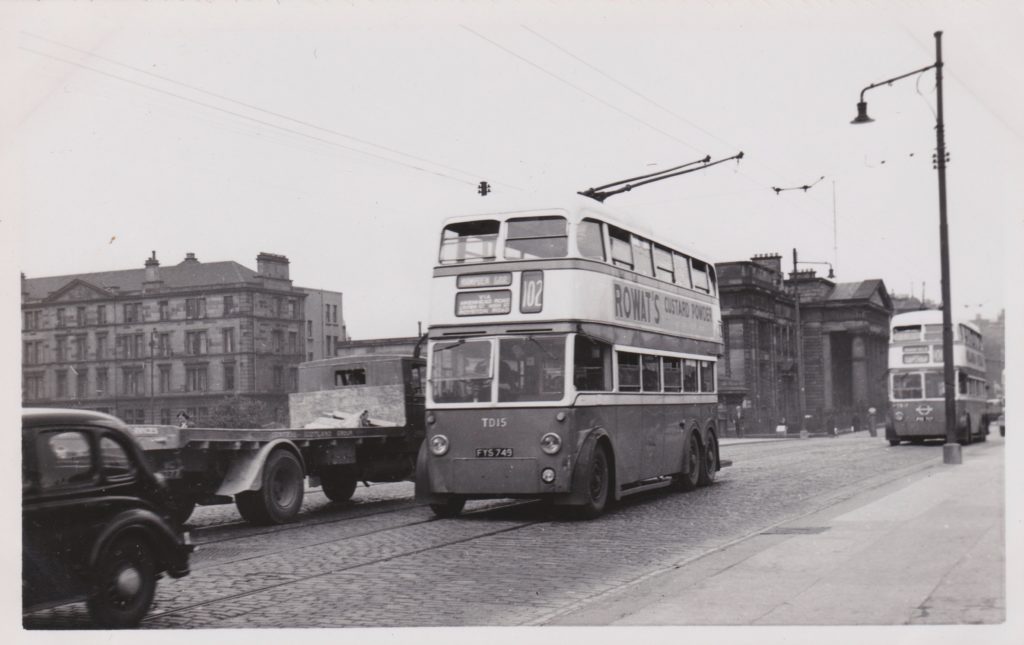












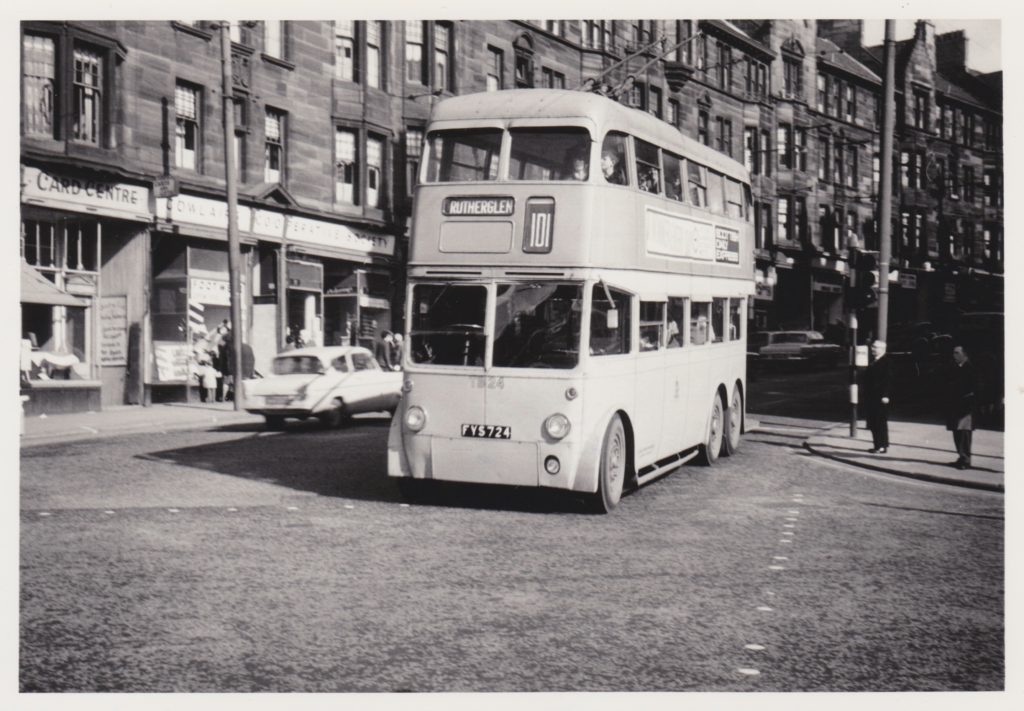


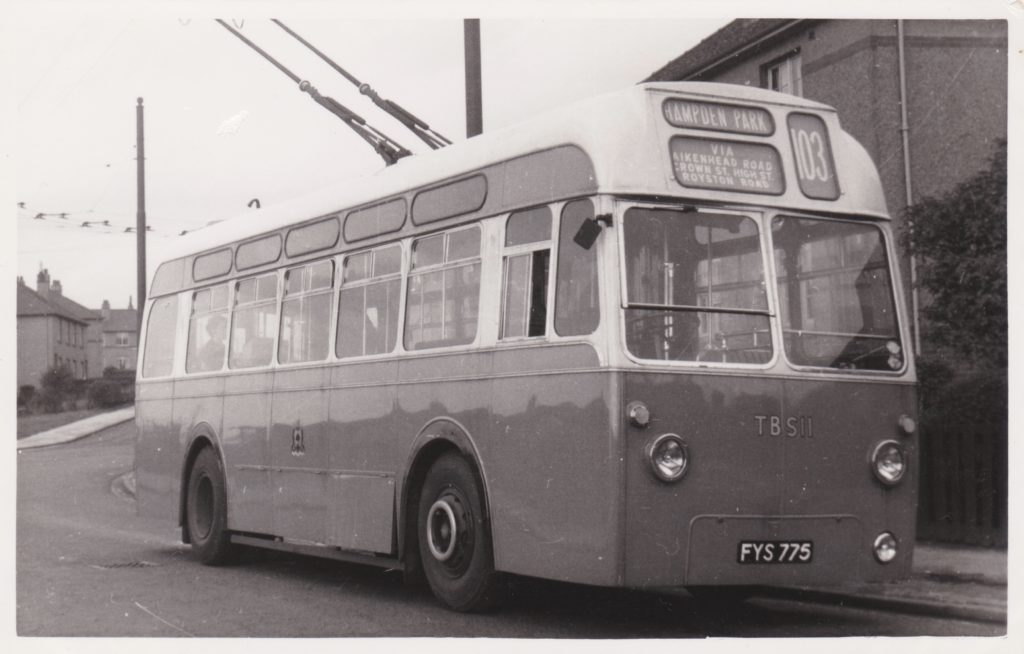
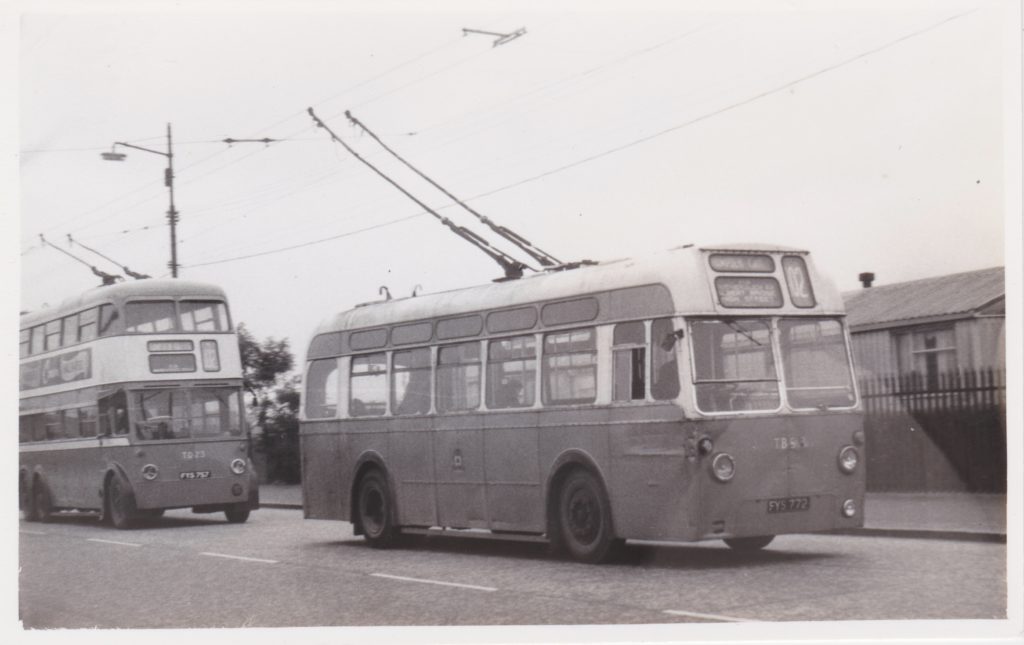



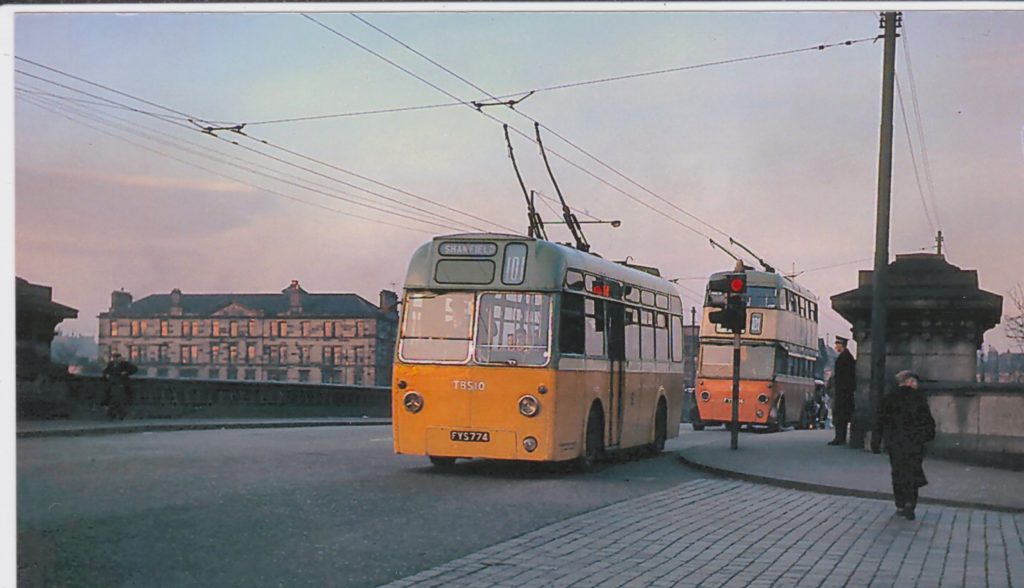








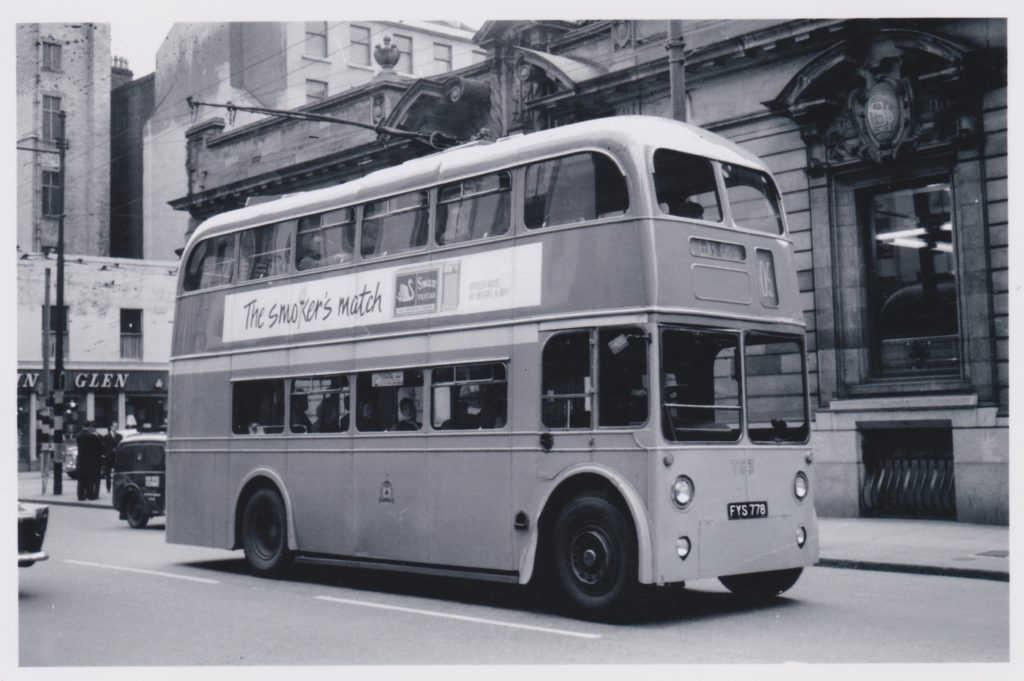

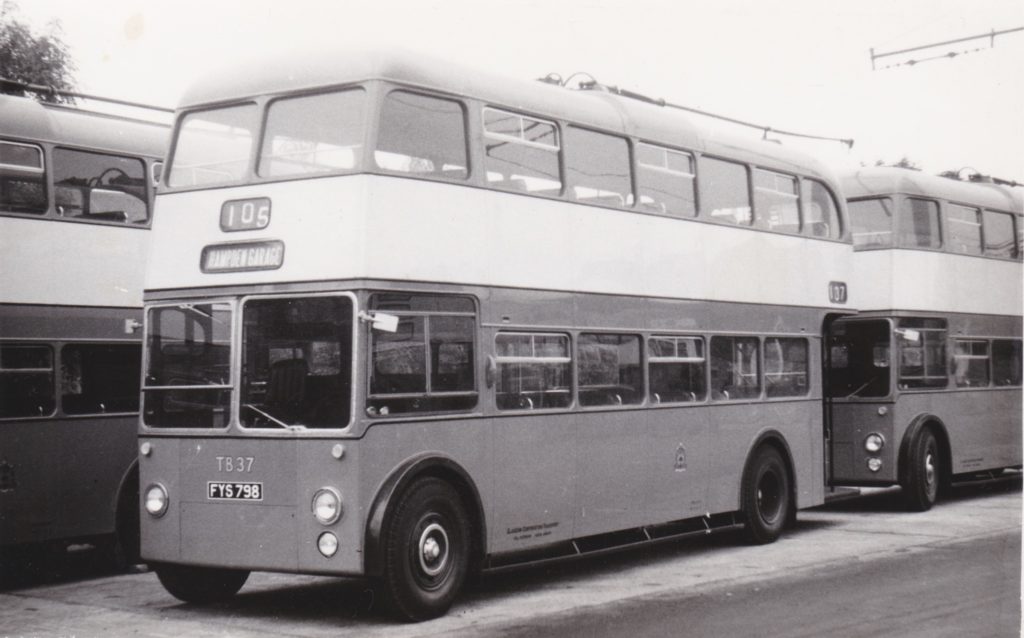



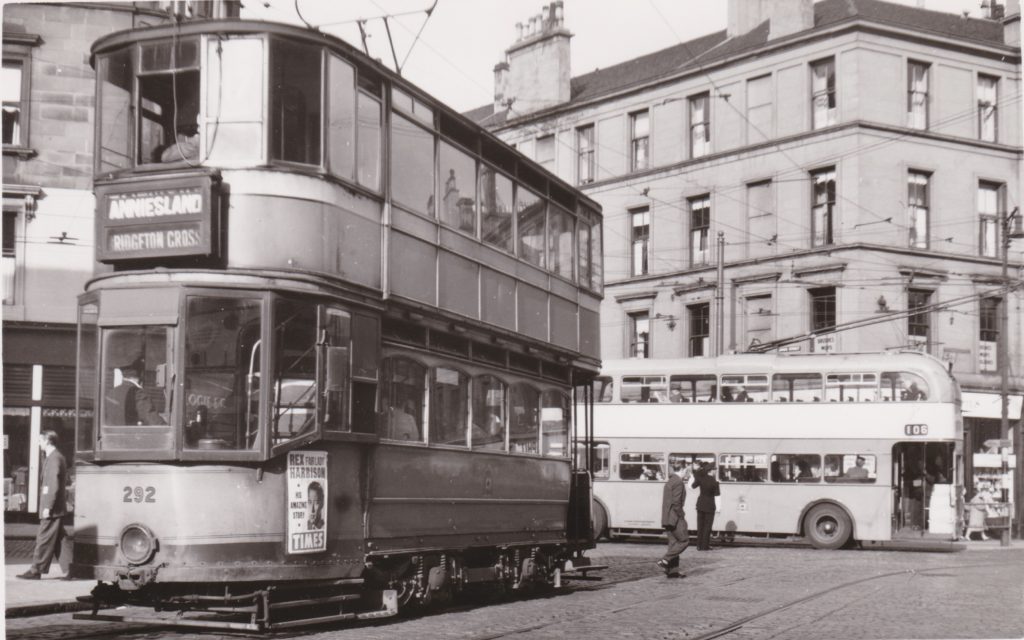
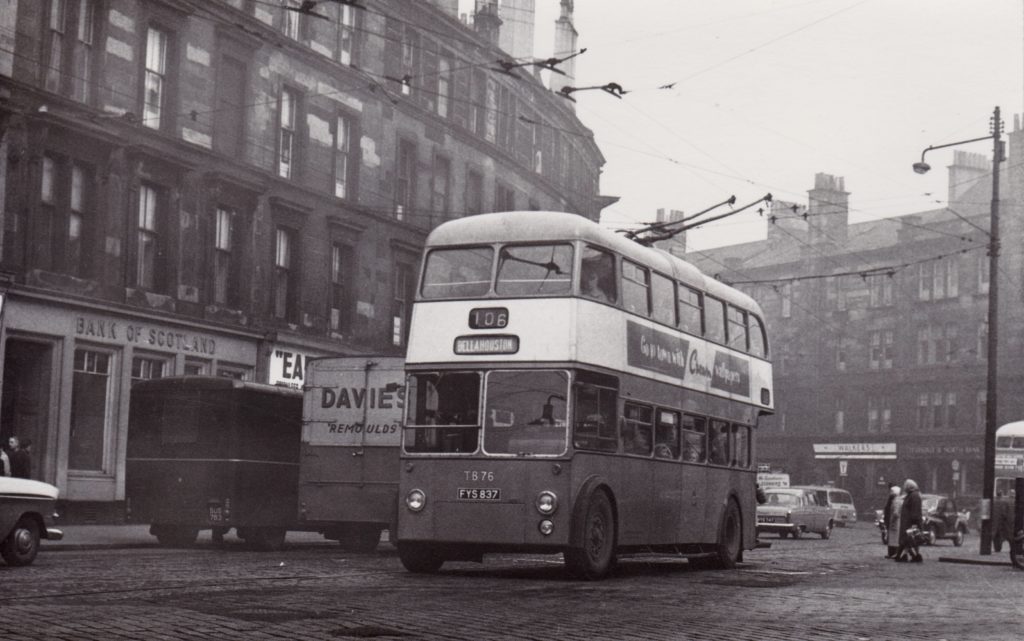




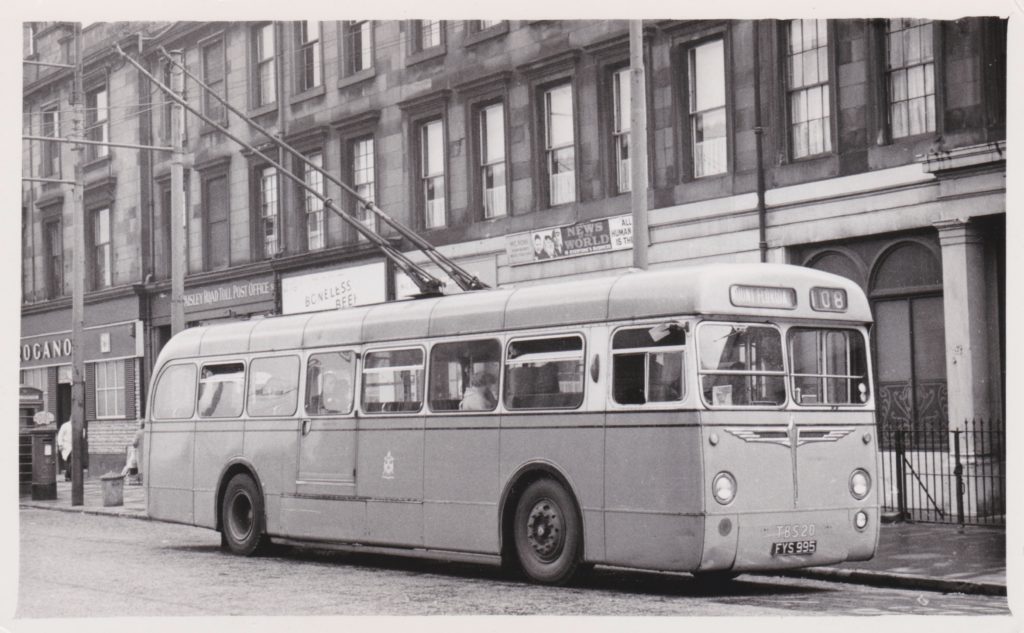




{ 9 comments… read them below or add one }
Hi Chris,
From November 1964 until October 1966, due to the Clyde Tunnel construction, the 106 trolleybus service no longer went to Linthouse. It used the Old Govan Town Hall at Princes Dock as a turning point to head back to Riddrie. I played there as a kid and only stayed a few streets away. I do remember the above, because there was an incident of a boy falling off a trolleybus after hanging off the side of it. Yes, I was that idiot.
Allan
Hi Allan,
Thank you very much for sharing this information and for your confession. I remember reading somewhere about a change to the trolleybus 106 routing because of the Clyde Tunnel construction and I believe the services on from Govan to Linthouse and Shieldhall were taken over by motorbuses.
I hope your fall from the trolleybus did no lasting damage.
All the best,
Chris
Hi Chris,
What a great chapter on the Glasgow trolleybuses! I lived there right next to Hampden Park and regularly used these buses to and from home and work.
There is one problem you have not mentioned, fire. Several trolleybuses went on fire, the reason for this was the fog. Glasgow at this time was not smokeless and was from time to time inundated with thick fogs. Naturally all transport was at a crawl and this resulted in the electric motors of trolleybuses overheating; fire being the result. There was such an incident just short of the depot in Aikenhead Rd.
Tom
Hi Tom,
Thank you very much for your comment and you are absolutely correct. Some trolleybuses did catch fire under these circumstances. Most were repaired and returned to service, but one six-wheeler, I believe in the TD series, had to be written off.
I was mad about the trolleybuses and would often go down to the depot at Hampden Garage on Aikenhead Road just to watch them coming and going.
All the best,
Chris
Service 106 was actually replaced by Motorbus service 65, from Riddrie to Bellahouston, on 1/11/1966.
K. Connock
Thank you K. for pointing this out and I have made the adjustment.
Chris
Hi Chris
Thanks for a fascinating record of Glasgow’s Trolleybuses. Living in Muirend and attending Holmlea School from 1952 to 1955 (when we flitted), I caught the latter years of the Trams to Muirend and Clarkston (“A Ha’penny Special, Please.”) and the early Trolleybuses on that long southern route. I recall vividly the huge-seeming 6-wheelers, which already looked pretty “tired” externally and the bright and shiny 4-wheel replacements, which tended to be driven more energetically. One familiar problem was that of sudden, jolting take-offs (causing many an elderly lady to stagger or fall on her way to her seat), explained by know-alls of the day as being due to worn motor or transmission rubber mountings, which had a very limited life. There were favourite vantage points for small, merry boys where the collectors tended to come adrift, involving the luckless driver and conductor in the filthy, often rain-soaked task of restoring contact with the overhead wires.
Gordon
Hi Gordon,
Thank you for your kind comment and for sharing your recollections of Glasgow’s trams and trolleybuses. Please forgive my delay in responding. It appears that I missed the original email informing me of your communication. With respect to the trams, I believe that the routes latterly serving Clarkston were the 5 and the 13. I did not experience them personally but I would be very interested in knowing more about the Ha’penny Special.
Glasgow’s first trolleybuses were indeed the richly appointed and no doubt very expensive six-wheelers which entered service in 1949/50. By 1953, when the Sunbeam four-wheel trolleybuses reinforced the expanding network, the six-wheelers had acquired a few dents but they were generally well maintained by the staff at Hampden Garage. I certainly remember the jolting take-offs that you mention and thought that they were explained by the driver putting his foot down too quickly. I also remember when the trolleybus experienced a dewirement and there would be a loud noise when a collector would bounce off the roof. It would require a considerable amount of strength and skill by the staff member handing the long bamboo pole to achieve a successful reconnection with the overhead wires.
Best wishes,
Chris
Hi Chris,
Thanks for a great read. I have fond memories of the 108 going past our house down Allison Street and also the 102 waiting at the terminus in Brerton Street near my Gran’s house. You can still see the supports for the cables on the walls of my old tenement.
Many years ago there was a photo online of the pretty Art Deco building at Hampden Garage before it was demolished but I can’t find it now. Do you know where it can be viewed? Thanks.
Paul